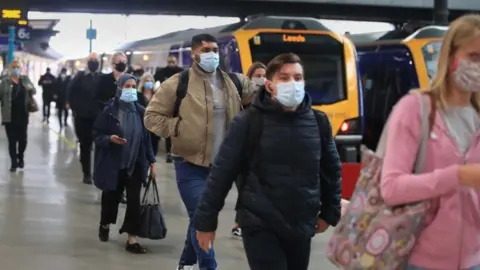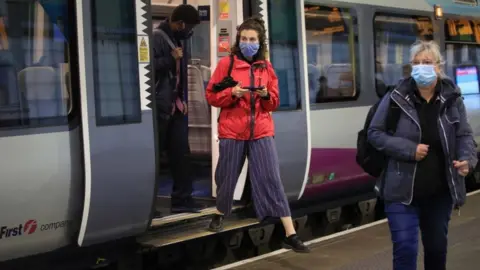Rail firms stress safety as more train services resume
 PA Media
PA MediaRail firms are reassuring travellers major efforts have been taken to ensure their safety as services increase.
Trains in England, Wales and Scotland were up to 90% of normal levels by Monday as schools reopen and people are encouraged to return to work.
Rail firms said anecdotal evidence suggested a slight increase in numbers but it was too soon for exact figures.
West Midlands Trains' Francis Thomas said there were "big changes", such as sanitising gel and one-way systems.
"If you haven't been to the railway station in the last couple of months you might find there's a one-way system at your local station, there's hand gel available and we've invested in anti-fogging machines that can spread an anti-viral on trains," he told the BBC.
"And there's plenty of space. We reckon we can carry about 40% of normal loads before we start to breach social distancing."
One passenger told the BBC: "I think you just have to get out… and then once you get out you kind of get rid of your fears."
Another reported there was plenty of space: "I come in on the Chiltern Railways line into Marylebone and the trains were a lot, lot longer, and they've, barriered off certain seats. It wasn't too packed."
Jacqueline Starr, head of the Rail Delivery Group, which represents train operators and Network Rail, said rail services were "doing everything they can" to reassure people travel was safe.
The group said no service was reported as "close to social distancing capacity".
Train operators across the country have designed the new timetable, taking into consideration potentially busy stations and parts of routes that will experience higher demand for travel by schoolchildren.
Where possible, more frequent services will be put on or extra carriages added to create more room.
Staff will also be on hand to explain the rules on wearing face coverings and maintaining social distancing to older children.
"Some train times will change so we're asking people to check before they travel and plan their journeys for quieter times if possible," said Ms Starr.


Over the coming weeks, rail bosses have a delicate balance to strike.
They want more passengers back on the network, but they don't want a flood of commuters crowding trains and stations.
Up to now, passenger numbers have remained low - on average, about a third of what it was before the pandemic.
The railways are not going back to where they were before the pandemic. Some services won't return. But in places, at certain times, more capacity will be created.
During the pandemic, the government has been covering the huge cost of running the railways without passengers.
So there is also a financial incentive for ministers that passengers return.

Train companies are now working to manage passenger flows by warning people if a particular service is busy.
Some modern trains, like those running on Southeastern and on Govia Thameslink, can monitor the weight load in carriages, allowing them to estimate the number of people on board.
Southeastern plans to share the data with passengers so they can avoid a specific train.
The Rail Delivery Group said that reducing the timetable during the coronavirus lockdown and then gradually increasing services again in phases had led to improvements in punctuality.
 PA Media
PA MediaIn particular, train operators and Network Rail had learned lessons about the effects of "wear and tear" on railway infrastructure, the effects "knock-on delays" caused to intensely-used routes, and the time trains take at each station.
"Before Covid one train was leaving a station at every second - we were congested. Obviously what this has allowed us to do is to look at the timetable and its resilience and to see where we can improve and increase punctuality and build and maintain that as we build back up the timetable," Robert Nisbet, regional director at the Rail Delivery Group, told the BBC.
Mr Nisbet added that the crisis had prompted another look at the way fares are structured: "The need for reform has never been stronger, specifically when it comes to fares."
He said the regulations that governed fares needed changing and that talks were being held with government on this issue - including changes to make season tickets more flexible.
Call to return
At the end of August, the government launched an advertising campaign encouraging people to go back to the workplace.
Business leaders have warned of damage being done to city centres as people stay away from offices.
However, many employers have no plans to return workers to the office.
The BBC questioned 50 big employers ranging from banks to retailers to get a sense of when they expected to ask employees to return to the office.
One of the main reasons given for the lack of a substantial return was that firms could not see a way of accommodating large numbers of staff while social distancing regulations were still in place.
